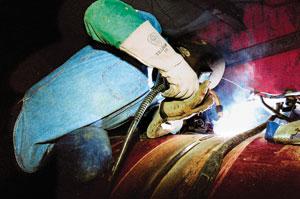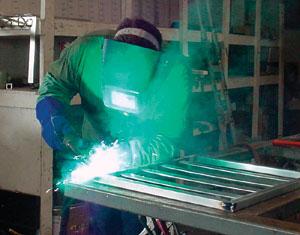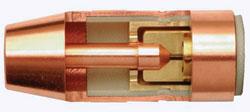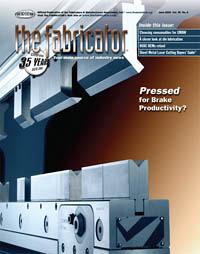Contributing Writer
- FMA
- The Fabricator
- FABTECH
- Canadian Metalworking
Categories
- Additive Manufacturing
- Aluminum Welding
- Arc Welding
- Assembly and Joining
- Automation and Robotics
- Bending and Forming
- Consumables
- Cutting and Weld Prep
- Electric Vehicles
- En Español
- Finishing
- Hydroforming
- Laser Cutting
- Laser Welding
- Machining
- Manufacturing Software
- Materials Handling
- Metals/Materials
- Oxyfuel Cutting
- Plasma Cutting
- Power Tools
- Punching and Other Holemaking
- Roll Forming
- Safety
- Sawing
- Shearing
- Shop Management
- Testing and Measuring
- Tube and Pipe Fabrication
- Tube and Pipe Production
- Waterjet Cutting
Industry Directory
Webcasts
Podcasts
FAB 40
Advertise
Subscribe
Account Login
Search
How to choose the consumables you use - Part I
Consumables for GMAW
- By Bill Giese
- June 14, 2005
- Article
- Consumables
 |
Many factors influence gas metal arc welding (GMAW) consumable selection. Chief among the factors is productivity. Because 85 percent of the cost of making a weld is labor, you need to choose consumables based on how well they improve welder productivity and minimize downtime (see Figure 1). To get the longest life from GMAW consumables, you need to know what to look for when making a decision. Three important consumables are contact tips, nozzles, and liners.
Contact Tips
GMAW employs continuously fed wire, and to transmit current to this wire, the welding gun must make electrical contact with the wire. This electrical contact occurs through a contact tip that the wire feeds through.
The contact tip's size corresponds to the wire diameter. For example, a 0.035-inch contact tip corresponds to a 0.035-in. wire. However, this is not the only consideration. The contact tip size you choose also depends on the application. Industrial applications require large contact tips, which have more mass and help to keep tip temperatures lower than small tips do.
 |
| Figure 1
In applications in which welds are visible on the finished product, look for consumables that require the least postweld cleanup. For example, components that improve arc starts and thereby reduce spatter result in less cleaning. |
Tapered and nontapered contact tips are available. Tapered tips typically are long and used with tapered nozzles in applications with restricted access and limited space, such as pipeline welding. Nontapered tips have more mass in the front and tend to hold up to heat better and last longer.
Contact tips also come in threaded and nonthreaded varieties (see Figure 2). Some styles of contact tips tend to seize the diffuser, making them difficult to remove and replace. Seizing is less likely to occur with nonthreaded contact tips. Nonthreaded designs typically have more area and conduct heat and electricity better than threaded contact tips, and often take less time to change after a burnback.
Threaded tips traditionally have been the most common—welders are accustomed to using them, and removal and installation are intuitive.
When contact tips start to wear, an oval hole can start to develop. This phenomenon, keyholing, can lead to irregularities in the arc from poor electrical pickup. Irregularities in the arc can increase spatter, which in turn leads to more postweld grinding. This is an inefficient use of a welder's laborevery additional minute of grinding time is one less minute of valuable production time.
 |
| Figure 2
Because nonthreaded contact tips do not require tools to change, they are quicker to replace after burnback. Some fabrication shops use tips that have just three settings, such as flush with the end of the nozzle, 1/8- or 1/4-in. recess, or 1/8-in. stick-out. Having fewer choices improves consistency among welders. |
Nozzles
The nozzle directs the shielding gas to the weld. Like contact tips, nozzles are either threaded or nonthreaded and come in many different shapes and sizes for various applications. Nonthreaded nozzles are easier to change than threaded nozzles, but because they have no threads, they don't fit as tightly as threaded nozzles do. Threaded nozzles are more secure, yet many require more effort to change.
Threaded nozzles generally stay on the gun better and offer better tip-nozzle concentricity. Slip-on nozzles generally are quicker to change and clean.
For spray arc transfer or pulse spray of solid wire, the nozzle should extend past the contact tip, which helps deliver the shielding gas closer to the arc when longer electrode stick-out is required. It also helps the contact tip run cooler.
In short-circuit transfer mode, the contact tip should be flush or extend only slightly past the nozzle, allowing for the short electrode stick-out required.
Since a certain amount of spatter with this type of transfer occurs, extending the contact tip can help to decrease the spatter buildup on the nozzle. This in turn allows the gas to flow unrestricted.
The size of the nozzle opening depends on the size of the weld puddle, the volume of shielding gas required, and the difficulty in reaching the area that needs welding. For example, for welding deep V-groove butt joints, a small, tapered nozzle may be necessary to get the contact tip close enough to the weld puddle. In contrast, high-voltage, high-amperage applications usually require high gas flow rates, so a nozzle with a large inside diameter gives better shielding gas coverage of the larger weld pool.
A good rule of thumb is to use the largest nozzle that fits the application. For an application that has restricted clearance or limited visibility, a small nozzle might be the best choice. But generally, bigger tends to be better because the larger the nozzle, the more gas coverage it provides. Some nozzles have built-in orifices that help direct gas, smoothing the gas flow and covering the weld better.
Nozzles typically are made from brass or copper. Copper nozzles are well-suited for use in heavy industrial applications because of their ability to withstand intense heat. Brass nozzles resist spatter better than copper, but tend to melt or burn when exposed to extreme heat.
Liners
The electrode wire is fed to the welding gun through a cable liner, and typically you need spring steel coiled liner for steel applications. Because these liners are steel, they are rigid, resist buckling, and have a long life.
Aluminum applications typically require liners made from nylon, Teflon®, or plastic, because these materials have lower friction than steel and they help keep contamination out of the weld. When aluminum wire is pushed through a steel liner, the wire can pick up little bits of steel that can contaminate the weld.
Liners need to be replaced because they wear out from continuous use or become kinked from improper use. Decreasing the friction between the liner and the wire and preventing improper use both help to minimize liner replacement and maximize welder uptime. Kinks in the liner cause the wire to catch and can result in erratic arc performance, which can lead to more operator downtime caused by more spatter cleanup.
To maximize liner life and reduce postweld cleanup, you can blow out the liner with compressed air. The liner can be blown out from the contact tip end or from the feeder end to remove dirt or copper flaking.
Liners usually need to be changed when you switch electrode size. Although some liners may be used for more than one wire size, if they are either too big or too small, they can cause poor feeding. One of the biggest causes of poor feeding is an improperly trimmed liner, such as one that is trimmed too short or trimmed so a burr on the liner impedes electrode feeding. Patented jump liner technology allows a toolless change of the most common liner wear point, which is at the radius of a GMAW gun's body tube, instead of the entire liner.
The liner size needs to match wire size, usually within a specific range. For example, a 0.035-in. wire typically is used in a liner capable of running 0.035-in. to 0.045-in. wire.
Cost Considerations
The optimal consumable is one that provides the best quality and the longest life. The better the consumable quality is, the less postweld work is needed, and the less downtime is incurred. Also, the longer the consumable lasts, the less time you spend replacing it. Time is money, and whether you are choosing a large power source or a small consumable, choosing the right equipment is essential to maximizing productivity.
About the Author
Bill Giese
449 W. Corning Road
Beecher, IL 60401
708-946-2281
Related Companies
subscribe now

The Fabricator is North America's leading magazine for the metal forming and fabricating industry. The magazine delivers the news, technical articles, and case histories that enable fabricators to do their jobs more efficiently. The Fabricator has served the industry since 1970.
start your free subscription- Stay connected from anywhere

Easily access valuable industry resources now with full access to the digital edition of The Fabricator.

Easily access valuable industry resources now with full access to the digital edition of The Welder.

Easily access valuable industry resources now with full access to the digital edition of The Tube and Pipe Journal.
- Podcasting
- Podcast:
- The Fabricator Podcast
- Published:
- 04/16/2024
- Running Time:
- 63:29
In this episode of The Fabricator Podcast, Caleb Chamberlain, co-founder and CEO of OSH Cut, discusses his company’s...
- Trending Articles
AI, machine learning, and the future of metal fabrication

Employee ownership: The best way to ensure engagement

Steel industry reacts to Nucor’s new weekly published HRC price

Dynamic Metal blossoms with each passing year

Metal fabrication management: A guide for new supervisors

- Industry Events
16th Annual Safety Conference
- April 30 - May 1, 2024
- Elgin,
Pipe and Tube Conference
- May 21 - 22, 2024
- Omaha, NE
World-Class Roll Forming Workshop
- June 5 - 6, 2024
- Louisville, KY
Advanced Laser Application Workshop
- June 25 - 27, 2024
- Novi, MI


























